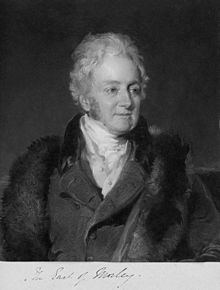Nationality British Role Politician | Name John 1st Alma mater Christ Church, Oxford Political party Whigs | |
 | ||
Born 3 May 1772 ( 1772-05-03 ) Spouse(s) Lady Augusta FaneFrances Talbot People also search for | ||
John Parker, 1st Earl of Morley (3 May 1772 – 14 March 1840), FRS, "2nd Baron Boringdon" from 1788 to 1815, of Saltram House in the parish of Plympton, near Plymouth in Devon, was a British peer and politician.
Contents
Origins
Morley was the only son of John Parker, 1st Baron Boringdon, of Boringdon Hall, Plympton, of Court House, North Molton, and of Saltram, all in Devon, by his second wife Theresa Robinson, daughter of Thomas Robinson, 1st Baron Grantham. His mother died when he was three years old and his father when he was fifteen. His father had employed the architect Robert Adam to complete the interior of Saltram House, rebuilt by his own father John Parker as one of the grandest houses in Devon. The Parker family had risen to prominence in the mid-16th century as the bailiff of the manor of North Molton, Devon, under Baron Zouche of Haryngworth.
Education
He was educated locally at Plympton Grammar School (which his father's friend the painter Sir Joshua Reynolds (1723-1792) had also attended) within walking distance of Saltram House, and at Christ Church, Oxford.
Career
Morley took his seat in the House of Lords on his 21st birthday in 1793. He was an active member of the House of Lords, initially supporting government policies until the death of William Pitt the Younger in 1806. After Pitt's death he supported George Canning, with whom he corresponded on political matters for many years. In 1815 he was created Viscount Boringdon, of North Molton in the County of Devon, and Earl of Morley, in the County of Devon. After Canning's death in 1827 he began to support the Whigs, and voted for the Great Reform Act of 1832. Apart from his involvement in national politics, Morley was also a great benefactor to public works in his home county of Devon and was a Fellow of the Royal Society. He made only minor additions to the family seat at Saltram, including the porch and enlargement of the library, 1818-20.
Marriage & progeny
Morley married twice:
Death
Lord Morley died at his seat of Saltram House in March 1840, aged 67, and was succeeded in his titles by his only son Edmund Parker, 2nd Earl of Morley (1810-1864).
